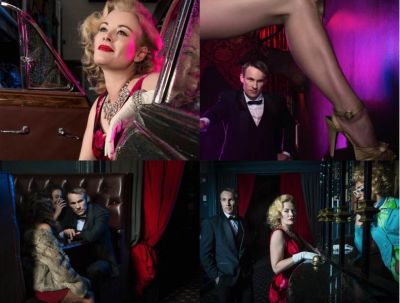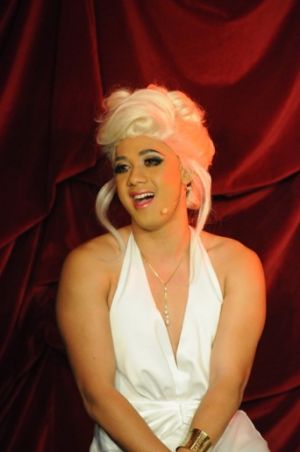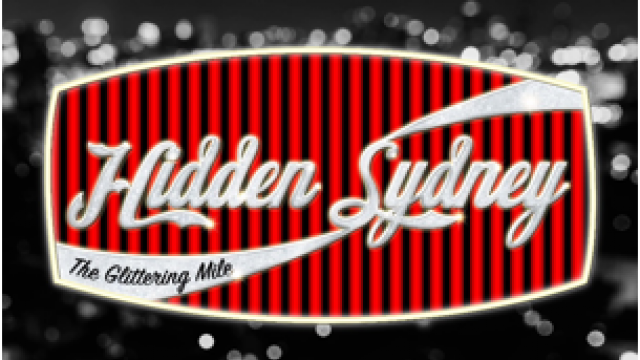Immerse Yourself in Old Kings Cross
Sydney’s Kings Cross of the 50’s, 60’s and 70’s springs back to life in an immersive cabaret event across four floors of infamous former brothel 'The Nevada' (now The World Bar) during September and October 2016. Executive Producer Olivia Ansell chats to Neil Litchfield.
You’ll mingle with characters ranging from barmen, homeless poets and drug dealers to performers at the Chevron Silver Spade and the showgirls from Les Girls when you enter the world of immersive cabaret show Hidden Sydney - The Glittering Mile, as quick-witted bouncers, madams of the night, drag queens, crooks, entertainers and eccentrics alike relive the world of the Cross during the 50’s, 60’s and 70’s.
Chatting to co-producer Olivia Ansell, I asked about the inspiration behind this immersive event.
“I’ve always been excited by the idea of immersive theatre, where the activity happens all around you and the audience are led through an experience, as opposed to sitting in their seats. It’s such a fast-paced world, with social media and the digital age. I think people want to be entertained in different ways, so this notion of immersion has played on my mind for some time.
“I’ve been to a lot of immersive shows in Europe, the U.K., and also in New York. One show in Copenhagen took me through the bones of an old hospital, and every time you went into a different hospital room, there was a different character telling a different story. They had 30 dolls lined up on a reception desk, and you had to choose a doll whose light was on – they had lights under their feet - and that doll signified which room you had to go in upstairs. This guy in a lab coat would lead you up there - it was like one-on-one theatre; you’d get shut in this dark room and the actor would do a monologue, and then you’d go back down to reception and pick a different doll. It was really whacky.

“I’ve been to another one where I got put into a car and taken 30 kilometres out to the countryside and it was actually a drive-in. All the cars had the audience in them, and you’d tune the frequency of the radio to listen, and the show was the artist was performing where the drive-in movie screen would have been.
“I’ve been to one in New York which was all about an Irish hotel. It was bigger than David Jones, and it was loosely based on a Jacobean tragedy – all very dark, movement and no text. You basically had to find the plot, so your job was to race after the actors and work out the plot. So when you came out, you all had different ideas of what the plot was, and that in itself was the plot – that no-one knows it, and you all work very hard to try to figure it out.”
So why Kings Cross, and why a cabaret event?
“I’d had quite a few experiences like that, but I thought, I’ve never really seen an immersive show with an undertone of cabaret or music driving through it, and I’ve never seen anything like that in Sydney to that scale.
“It had been bubbling on my mind for some time, and with Kings Cross gentrifying, and the lockout laws, with a lot of business having to close, and not just nightclubs and strip clubs, but associated businesses like restaurants and retail. So the strip is not as you knew it – there’s all these iconic neon signs, some were heritage listed I believe, no longer flashing, or not even there. So it is changing.
“The thing about Kings Cross is that everyone has a story, and certainly in the 20th century, I believe that Kings Cross gave Sydney its personality; its vibrancy.
“The Vietnam War turned Kings Cross into the entertainment district. It was already heading there in the 60s, and then with the clubs, the Chevron Hotel, the Sebel Townhouse, The Manzil Room, The Roosevelt, the Metro Theatre, the Kings Cross Theatre. We had the Stadium, where Frank Sinatra and Dusty Springfield played. It was the happening part of town. That’s where all the best hotels were, all the stars stayed up there – The Beatles stayed at the Sheraton, which is a now little block of orange 60s flats, sandwiched between two new buildings on Macleay St.
 “Everyone flocked to the Cross - all the immigrants had restaurants there; it was where you could get great Hungarian food; it was the culinary mecca of Sydney.
“Everyone flocked to the Cross - all the immigrants had restaurants there; it was where you could get great Hungarian food; it was the culinary mecca of Sydney.
“It was the happening part of Sydney. It was colourful identities like Abe Saffron, who owned a lot of the clubs, and set up Les Girls with Sammy Lee, who were responsible for giving it its charisma, and also its underworld. Alongside all the nightlife, entertainment and glamour, there was also a very serious underworld going on.”
And what led to actually staging this immersive cabaret event in one what was one of the more colourful and iconic brothels of the era?
“I met up with Steve Ward, who is part of the management at The World Bar. That venue has been many things; it was a doctor’s residence from the 1800s into the 20th century, then later on it was an artists’ squat in the 50s and 60s, then it opened as ‘The Nevada’, which was one of Sydney’s most notorious brothels. It had the biggest bed in the world.
“I went down and did a reccy of the space with Steve, and the old Victorian balconies, the stairways, and the way that the some rooms have been left in their glory, while that other rooms have been done up and restored to their former glory - I just fell in love with the venue, and thought these rooms just echo so many stories.
“Apparently there’s a ghost in ‘The Nevada’, the old caretaker - and there’s a few ghosts on the top floor. When you’re out there late at night you can often feel the wind of someone walking around.
“Those balconies were very famous – they used to line all the women up on the balconies to whistle up the trade from Bayswater Road.

“It was the first port of call for any young lass wanting to make a bit of money upon arriving in Kings Cross, before many of them figured that ‘The Nevada’ took too much commission – 50 percent – so they moved down and shared the strip of Palmer Street with some of the transsexual prostitutes.
“I just thought, it’s ‘The Nevada’, it’s on Bayswater Road, and The World Bar are doing very well, hanging in there as a nightclub business. If you take a walk down that end of Kings Cross, all the other nightclubs have closed. Even in the time that we’ve been researching the project, 42 late night entertainment businesses have closed in that area since the concept sprang to mind, and everything is zoned for residential apartments.
“There’s little back laneways, which feature on ‘Underbelly’, that aren’t going to stay for long, and they just reek of the history of the Cross. As I walk around I take a really good look, because you just don’t know how long it’ll be there.
“Then of course, in a more sophisticated manner, that little stretch on Orwell Street down at the Metro Theatre and near The Roosevelt is just glorious. You stand back on Llankelly Place looking towards those two buildings and you’re just so taken by it; you can just picture the old 50s Jaguars pulling up and gorgeous women getting out and going to the theatre and the bars.
“It’s the charm of the venues, the gorgeous architecture of the Victorian terraces and the way they sit there so beautifully at night. It gives you a real snapshot of Sydney in the 1900s and right throughout the 20th century. It’s wanting to preserve just a little bit of our history, and being able to identify the stories of the Cross in years to come.

“We’ve researched about 50 different iconic characters that inhabited the cross, and director Lucas Jervies whittled it down to a vignette of ten scenes that we feel best fit together for the show.”
Hidden Sydney - The Glittering Mile promises audiences will immerse themselves in the stories of Bea Miles, Abe Saffron, Roie the Witch, Standover Jim and the iconic Les Girls, while rubbing shoulders with the crims and crooks of the day, before finishing up with last drinks at the Chevron Silver Spade.
“The audience come through the building in rotation, with up to 60 per rotation, and the show times are 30 minutes apart. People congregate in the back laneway, Mansion Lane, and the very first scene happens right there in the lane, and let’s just say that the entire lane is engaged in the scene, from local business, to people, to traffic. It will be very hard to ascertain who’s an audience member, and who’s actually an actor.
“Then you’re invited inside, and the minute you step inside on the ground level you’ll be taken back to the 1960s at ‘Les Girls’, and so it goes, thoughout all the levels of the building.
“There’s a wonderful scene, ‘Who Killed Anita’ (murdered Mark Foy’s heiress Juanita Nielson), which is a kind of Spanish Rock Opera between two drag queens and two thugs in the Carousel Nightclub reception, who all know something about where Juanita’s body ended up. They haven’t been able to say anything for fear of being popped off.

“From one thing to the next, you become part of the Kings Cross fabric, so you might find yourself on the balcony and whistling up trade yourself, as you move through the experience.
“Then once we get to the top, after really feeling like you’re part of this seedy brothel, we drag you to one of the most glamorous clubs in town, where some of the biggest international stars performed. We take you back to the Chevron Silver Spade, where you had the likes of Dusty Springfield, Helen Reddy, Jerry Lewis, Sammy Davis Jnr and Tony Bennett – a smorgasbord of stars that came out on rotation. Can you believe that in any given month an artist with a name that big played a big supper club of 800 people for a sit-down dinner, doing two shows a night – that was the kind of international glamour we had on rotation in Sydney.
“Just on that Glittering Mile stretch, there were so many clubs. There was just so much work, and the orchestras – you were either in the Silver Spade orchestra, or you were down at Chequers, or the Rushcutters Bay Stadium, or the Manzil Room, or the Jazz Cellar.
“Warren Fahey, the songwriter, spoke of going and hearing brilliant jazz, and everyone was drinking milkshakes. You couldn’t get a liquor license past 6 or 7 pm. It was very innocent. It was all about wonderful entertainment. It wasn’t until the Vietnam War, when all the GIs were docking down at Woolloomooloo, that in came the sex trade and the drugs started to infiltrate. The Vietnam War turned The Glittering Mile into a different sort of beast.
“Many say that by the 80s you wouldn’t want to know it, but in the 50s and 60s it was all entertainment, glamour, and the place to be seen. By the 80s it was a rock’n’roll scene; the Sebel Townhouse was legendary; it was promiscuous; and by the 90s we got well into the nightclub trade, George Freeman and John Ibrahim became friends, and as you can see from The Golden Mile series, the rest is history – it became a metropolis of nightclubs.
“As much I’d love glamorous looking apartments lining the street of The Glittering Mile, there is a sense of nostalgia and history that you don’t want to lose. I drive down there and the Love Machine sign is sitting there permanently turned off, and it’s just a little empty door. One understands that everything has to gentrify and move on, but I wish there was a way to take some of the iconic artefacts like the Pink Pussycat, and the Love Machine sign and put them somewhere, or do something.
“With all the apartment buildings that are being built, one can only hope that small galleries and music bars are restored, but the government will have to play ball for that to happen, and loosen up some of the laws surrounding that.”
The Ensemble cast ofHidden Sydney - The Glittering Mile features Ray Badran, Gerard Carroll, Lauren Clair, Gary Clementson, Paul Dowson, Virginia Gay, Ben Gerrard, Thomas Gundry Greenfield, Christa Hughes, Fiona Jopp, Brenden Lovett, Rob Mills and Aaron Robuck.
The season continues until October 9.
Subscribe to our E-Newsletter, buy our latest print edition or find a Performing Arts book at Book Nook.

